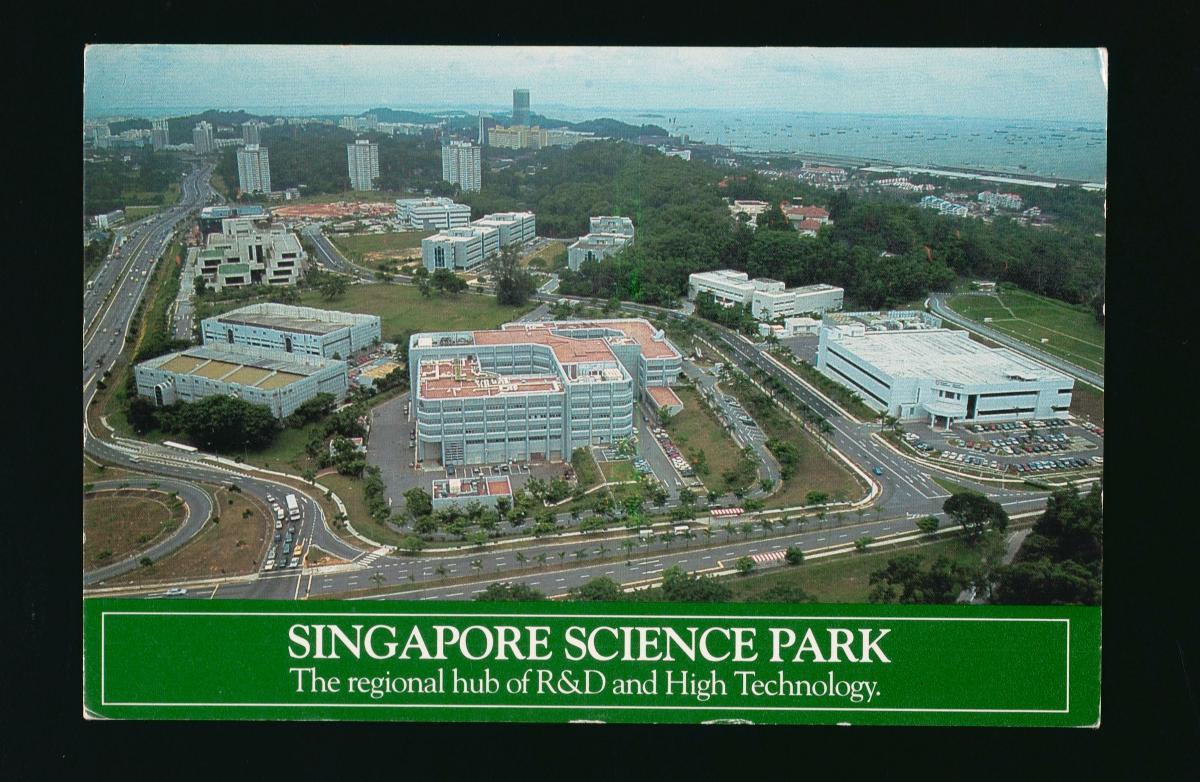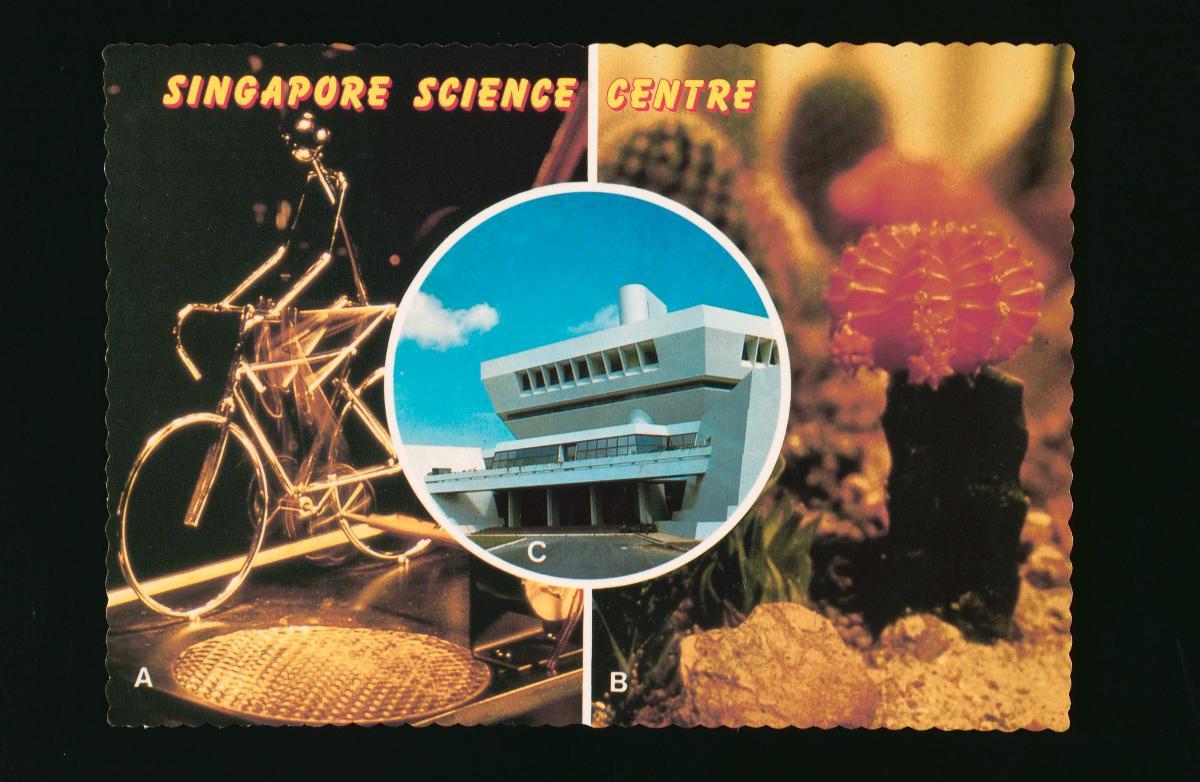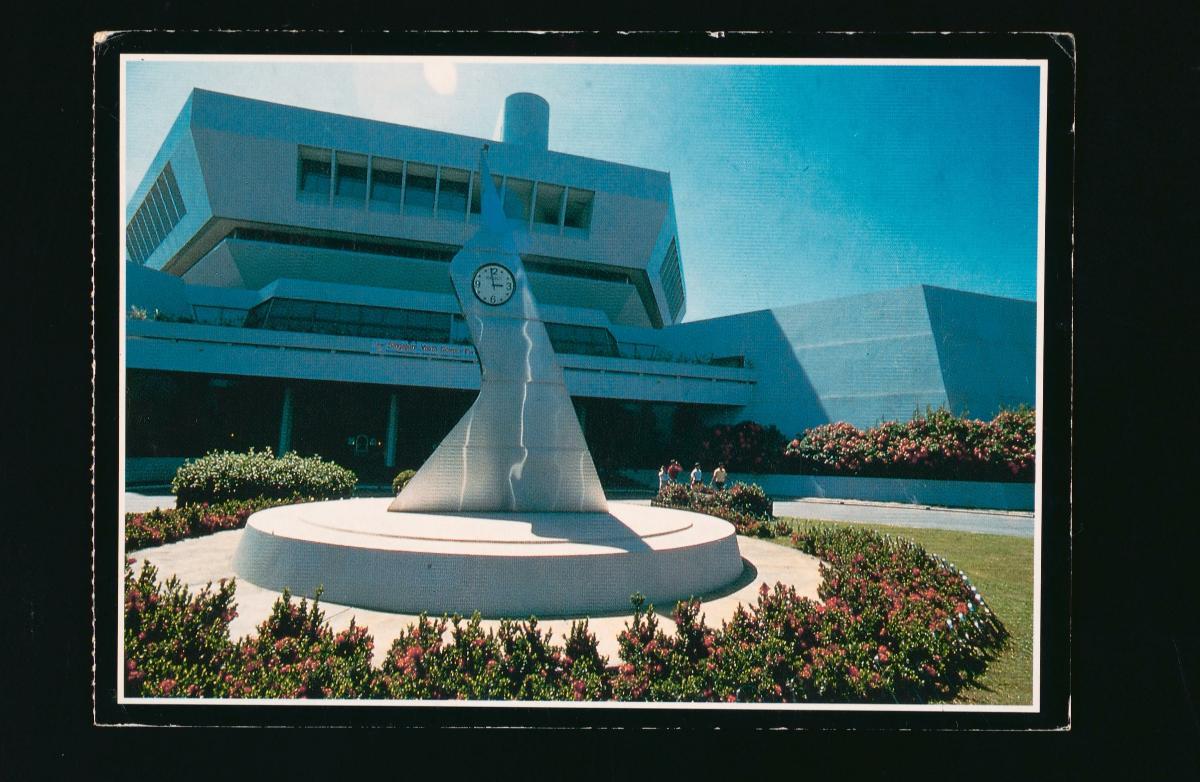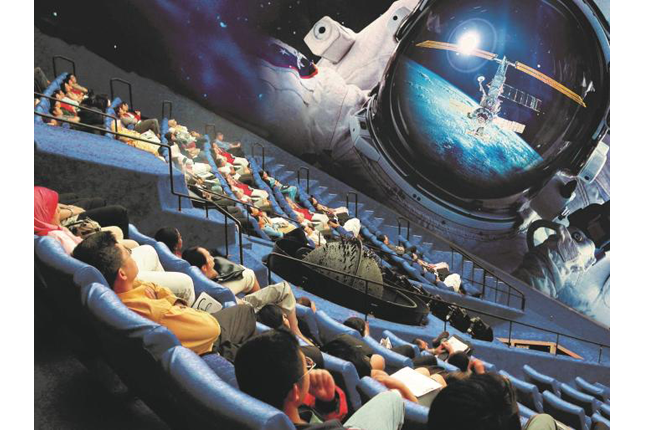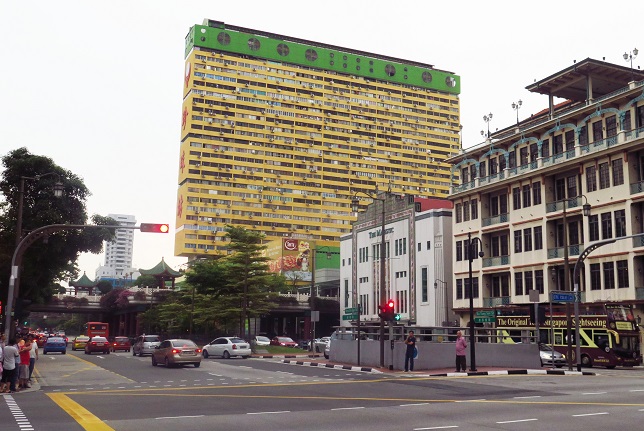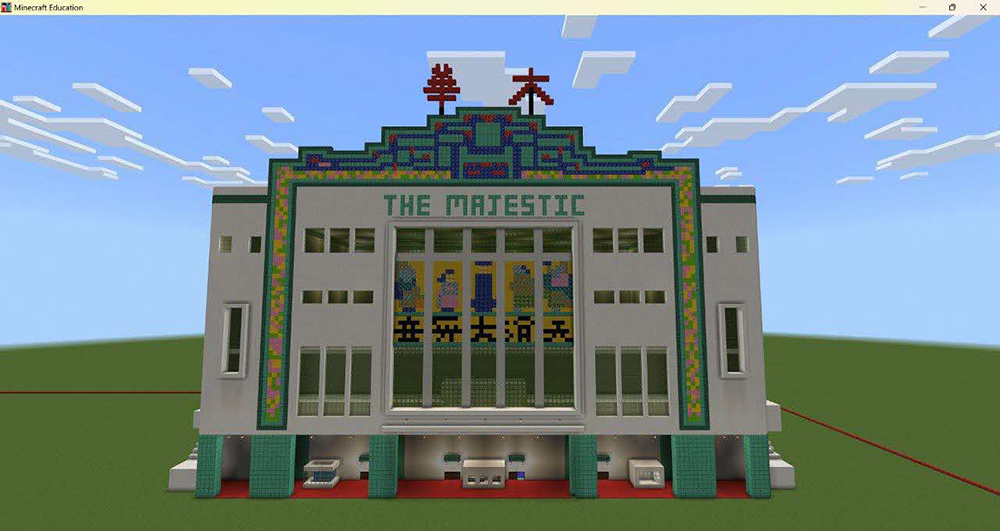TL;DR
Singapore’s very own Silicon Valley: From repurposing pig hearts for human needs to harnessing the humble mushroom to help stop cancer in its tracks, the revolutionary Singapore Science Park was the site of numerous firsts as the city-state explored a new frontier in science and technology in the 1980s.In the dark of the night, special packages containing pig hearts steeped in brine used to be delivered to the Singapore Science Park. Workers in white overalls had the delicate task of unboxing them and extracting the aortic roots of the organs the next morning.
The roots formed the raw material for which Pacific Biomedical Enterprises produced artificial heart valves to replace malfunctioning human ones1. The company was Singapore’s first artificial heart valve maker when it opened at the Singapore Science Park in 19872.
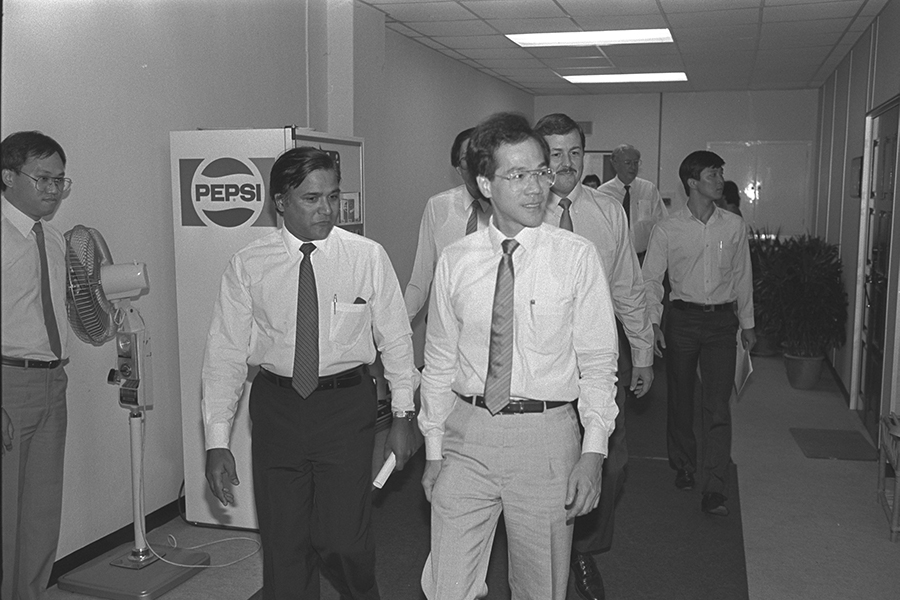
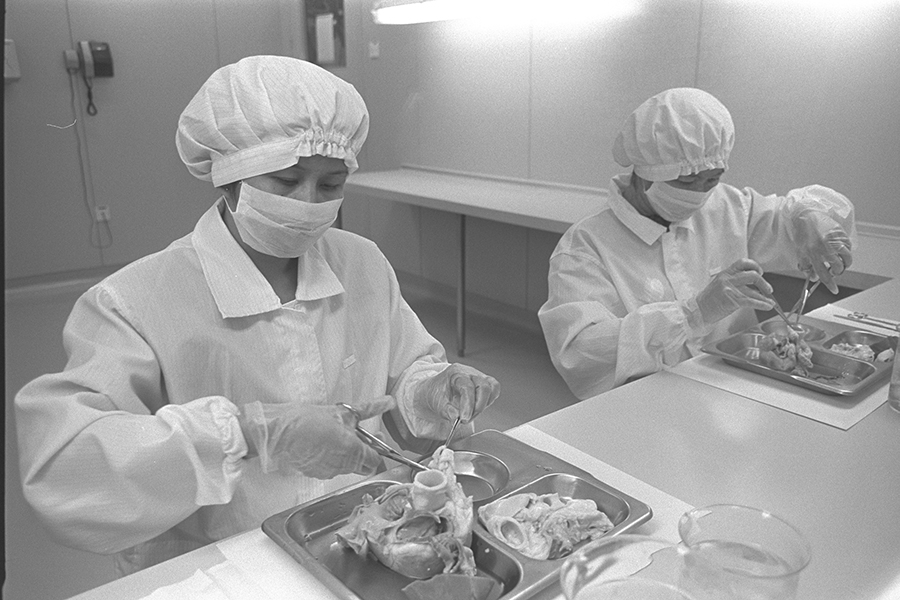
Acting Health Minister Yeo Cheow Tong at the official opening of Pacific Biomedical Enterprises at 51A Science Park Drive. Courtesy of National Archives Singapore.
The pioneering life-saving endeavour, aimed at plugging the shortage of human organ donors, was one of numerous groundbreaking and cutting-edge ventures housed within the park following the complex’s soft launch3 in Pasir Panjang in 19824.
Take the case of the humble shiitake mushroom. It was at the Singapore Science Park that National University of Singapore (NUS) biochemist Dr Tan Kok Kheng5 took a stab at extracting lentinan, an anti-cancer substance in the carbohydrate cell walls6 of the fungi. The company went into full production at the park in 19837.
The park was also where the first programmable robots for educational and industrial purposes8 were made as a result of a Singapore-US partnership between local company Intraco and Seattle's Scien-Tech the same year.
Envisioned as the Silicon Valley of Singapore and the epicentre for the nationwide push towards knowledge-based industries, the Singapore Science Park was the city-state’s first research & development (R&D) business park where movers and shakers such as scientists, inventors, economists, engineers and marketers converged to push the known limits of their fields.
Along the way, other brand names set up shop at the Science Park.
Seagate Technology, which made hard disc drives, established a facility for development work at the Science Park in 19849. That decade, Singapore earned the distinction of world’s leading producer of the device10.
Then, in 1990, the century-old11 Japanese Shimadzu Corporation cemented its supply lines for high-tech medical equipment like gamma cameras, X-ray C T scanners, and Magnetic Resonance Imaging systems to hospitals in the region. This followed the opening of its R&D and marketing base at the park12.
In 1996, the park hosted the Cray T94, one of the world's most advanced supercomputers, providing Singapore "access to state-of-the-art technology in high performance computing".13
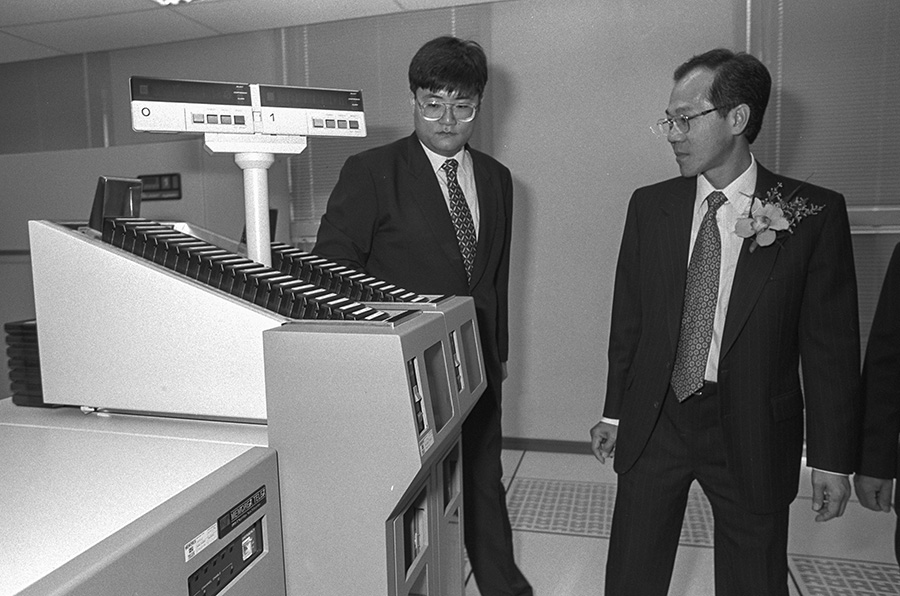
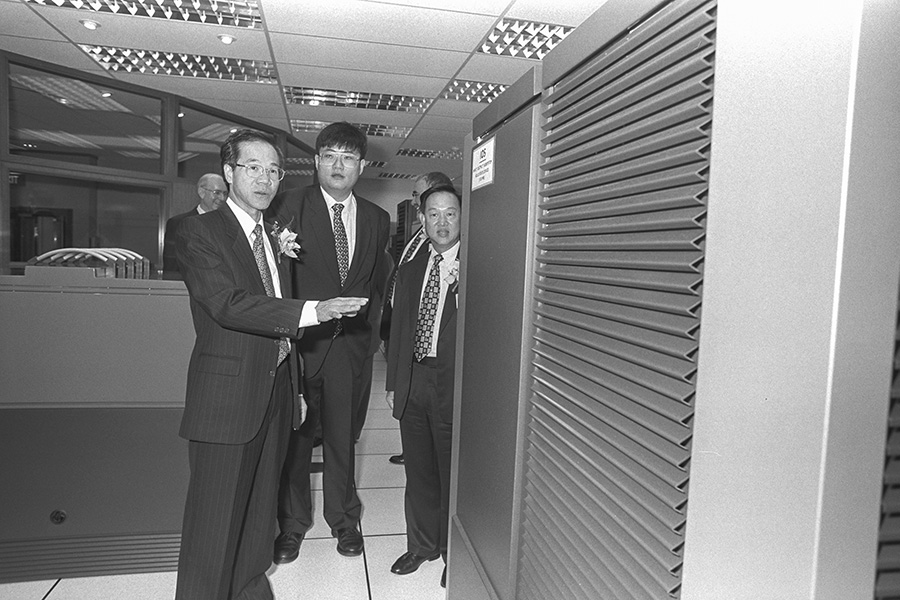
Minister for Trade and Industry Yeo Cheow Tong (on the right in the first image and left in the second image) viewing equipment after commissioning the Cray T94 supercomputer at the Singapore Science Park on 19 April, 1996. Courtesy of National Archives Singapore.
Today, the Singapore Science Park is a thriving technology and development hub home to 12,000 people across 350 laboratories, multinational corporations, and global leading technology companies and R&D institutions such as the Institute of Microelectronics, Johnson & Johnson and Shopee. How did it all begin?
Rebooting the Economy: Conception & Inception of the Singapore Science Park
Following the decline of entrepot trade in the 1950s, Singapore chugged forward in pursuit of a new industrial reality.14 In the decades that followed, flatted factories and assembly lines, where appliances like Setron television sets and Rollei cameras were rolled out, characterised much of the production landscape.15 Processing plants, where textiles and pollutive wood chips were produced, also emerged.
By the late 1970s, it was time to shift gears. The goal? Transition from producing things to ideas.16
With rising educational and living standards, and the economy bursting at maximum employment 17, Singapore began exploring higher valued capital and skill-intensive activities.
After attaining the green light to consolidate national R&D efforts, the Science Council — formed in 1967 to advocate for national advancement in science and technology — mapped out plans for a revolutionary science park. The Economic Development Board (EDB) and Jurong Town Council (JTC) were charged with its development.18
First, there was the matter of site selection. JTC chairman Tang I-Fang, an engineer and economist by training19, settled on land near the National University of Singapore and National University Hospital with the intention of fostering rapport between academia, medicine and industry for real world solutions.20
Next, a whirlwind trip around the world was planned to glean insights from the best of the best. A team, which included JTC’s Swee Kee Siong, set forth to explore the United Kingdom’s Cambridge Science Park, America’s Silicon Valley and Stanford Research Park, Taiwan’s Hsinchu Science Park, and Korea’s Daedeok Science City.21
Mr Swee recalled: “To be frank, we knew very little about science parks. Our forte was in industrial land, and this was so different for us. Once we returned (from the trip), we immediately started to incorporate the learnings into the master planning for Singapore’s first science park.
“Even though none of us at the time were researchers or scientists, we could still contribute to the R&D ecosystem of Singapore… We wanted to develop the Singapore Science Park as the place for the country’s R&D drive and initiatives to take root and flourish.”
Textures of the Park
In contrast to the no-frills factories and industrial compounds of yesteryear, the Singapore Science Park drew inspiration from the lush, sprawling and impressive campus designs of the world’s top universities.
An unfenced and porous terrain in a sylvan setting where “buildings harmonised with nature to inspire workers to achieve better results”, was the result.22
In an interview, JTC’s Seetoh-Yam Kum Chun, tasked with planning the park, noted that the complex even had a pocket park with fauna and water features. She added: “This was also the first time that we had ever conserved trees. Together with a United Nations representative, we had to study the wooded environment to save as many trees as we could and to preserve the natural terrain, where possible.”23
Building works kicked into high gear in 1981. Blocks bore the last names of legendary scientists and inventors such as Blaise Pascal, Gregor Mendel and Alexander Fleming.
While this was under way, an admissions committee comprising representatives from NUS, JTC, EDB, the Singapore Institute of Standards and Industrial Research (Sisir), and the Applied Science Corporation and Defence Science Organisation, sought tenants whose work would help the nation achieve its R&D ambitions.24
In 1984, the Singapore Science Park officially opened to fanfare. The event was graced by royalty — Norway’s Crown Prince Harald — and officiated by Singapore’s Minister of Law EW Barker. In true 80s’ fashion, bubbly was popped with celebratory champagne gushing down a pyramid of glasses to celebrate the park’s official beginnings.
The event also marked the opening of the $10 million centre of its first tenant — the Det Norske Veritas Marine Technology Centre — one of the world’s largest companies in ship classification and certifications.25
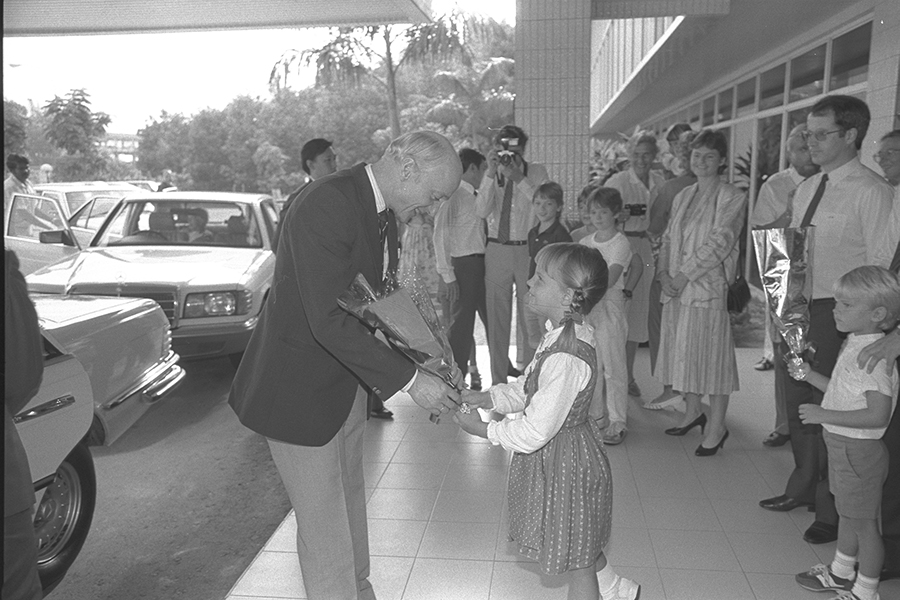
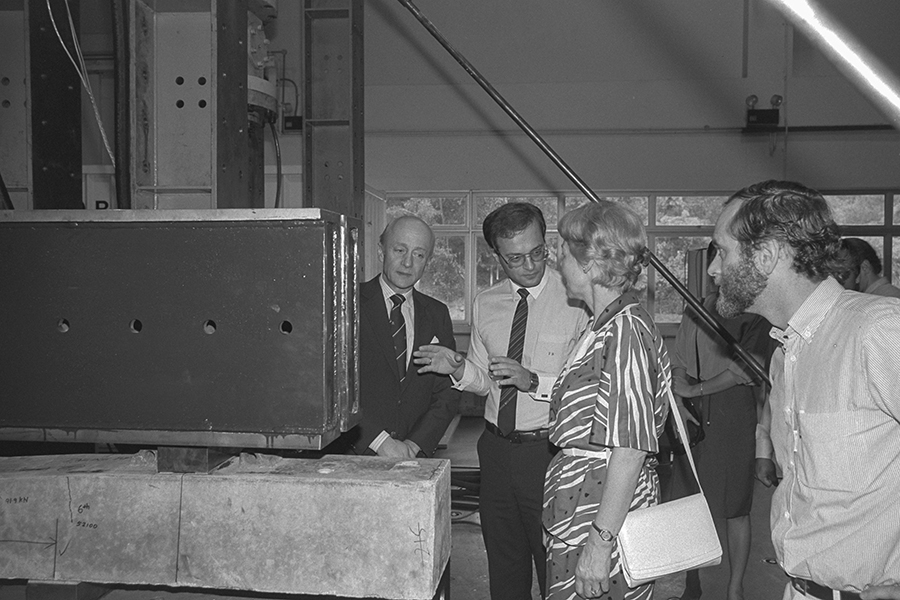
Norwegian Prime Minister Kaare Willoch and Wife visit Det Norske Veritas Marine Technology Centre at Science Park Drive. Courtesy of National Archives Singapore.
A Convergence of International Minds
The $500 million Science Park drew 34 R&D organisations between the years 1983 and 19872627. Many were involved in important work, with some racing against time to meet urgent healthcare needs. For instance, as HIV/Aids raged worldwide, killing thousands including its first victim in Singapore in 198728, researchers at the park worked tirelessly to produce virus proteins for diagnostic testing.29
Research was also being conducted to better understand the Epstein Barr virus, known to cause nose and throat cancers among Asians in particular.30
Attracted by multiple factors such as healthy growth prospects, grants, tax incentives, and competitive rental and lease rates, companies like Fujitsu31, Pfizer32, Shell33, Silicon Valley-based ASK Computer Systems34, as well as Reuters Holdings which set up a $40 million R&D centre35, started operations at the park.
Singapore was fast becoming an intellectual entrepot centre. The park was also home to local agencies such as Singapore’s National Computer Board.36
In a speech marking Technology Month in September 1989, Mr Mah Bow Tan, Minister of State for Trade and Industry and Communications and Information, described the park as home to “a thriving dynamic little community” of more than 2,000 workers, many of whom were R&D workers.37
By then, 50 organisations engaged in a broad spectrum of technologies including biotechnology, computer and information technology, microelectronics, marine technology, and chemical engineering had moved in. Many had built state-of-the-art laboratories.
Mr Tan, noting that the spirit of entrepreneurship and innovation was “alive and kicking”, also highlighted noteworthy industry-academic collaborations including a joint project between Singapore Biotech and NUS’ department of pathology to produce a rapid immunologic diagnostic kit for thalassaemia screening.
In 1993, Singapore took another leap towards becoming a technology city with the launch of the $291 million 20ha Singapore Science Park 2 along roads in Buona Vista and Pasir Panjang.38 Its first tenant was the Institute of Microelectronics.39
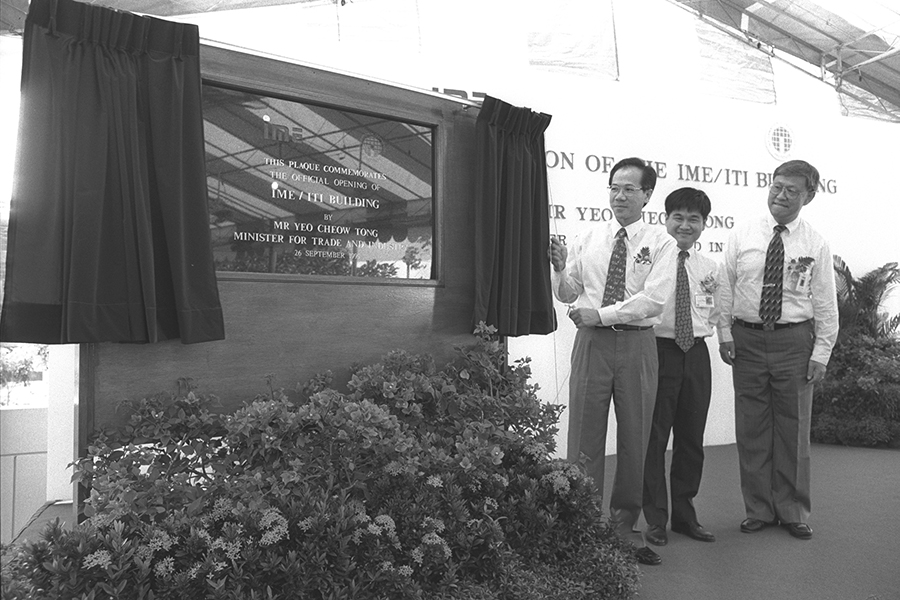
Minister for Trade and Industry Yeo Cheow Tong unveiling commemorative plaque during opening of Institute of Microelectronics (IME)/Information Technology Institute (ITI) building at No. 11 Science Park. Courtesy of National Archives Singapore.
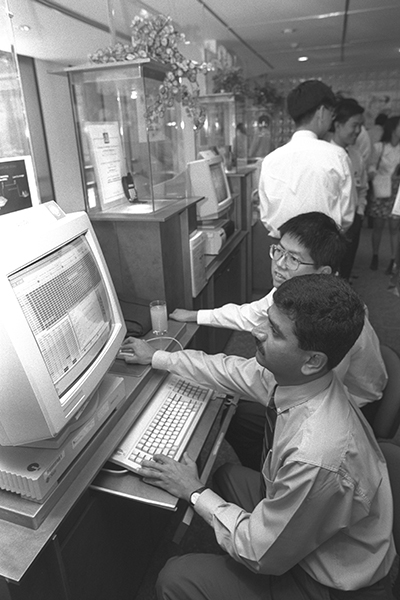
Guests touring the Institute of Microelectronics/Information Technology Institute building at No. 11 Science Park II during its opening on 26 September 1995.40 Courtesy of National Archives Singapore.
Interaction, cooperation, and joint projects between university staff and tenants in the Science Park, considered critical elements in contributing to the park’s success, continued to be emphasised. To encourage mingling, lifestyle amenities, a clubhouse, and even restaurants including a place called Spot in the Hub, opened on its grounds.41 Diners recount cosy dinners lit by oil lamps in laboratory jars and fusion dishes which ignited the senses.
A number of formal initiatives were also launched to foster such connections:
- In 1986, Sisir announced the establishment of a R&D Incubator Centre42 to nurture up-and-coming local firms.43
- In 1993, The Innovators Club, a fraternity for R&D professionals to meet and exchange ideas, opened.44
- In 1996, an $11 million Innovation Centre, a one-stop high-tech facility for budding entrepreneurs and companies, was unveiled. It offered amenities like meeting rooms and services such as secretarial support.45
With the benefit of being ahead of the curve, Singapore became a model for other science parks. Its concept was exported to cities like Bangalore in the 1990s46, and inspired many-a-visiting dignitary and industry leader.
Makeovers and a New Phase of Growth
Rivalling international R&D facilities, new buildings rose at the park as part of a comprehensive $400 million makeover beginning in the late 2000s. This largely impacted Science Park 1.
The 2000s also heralded the arrival of Lilly, the first drugs company to set up an R&D centre in Singapore47, tissue banking firm CordLife, and food company Danisco which produces ingredients for ice-cream makers across the globe.48
Singapore has since made significant strides towards becoming a R&D powerhouse with other complexes such as one-north springing up in the wake of the park’s success.49
The Future is Bright
Alongside the likes of Zurich, Oslo and London, Singapore was ranked the 7th smartest city in the world in the 2023 global Smart City Index.
Exciting experiments, thoughtful inventions and practical innovations at the Singapore Science Park contribute to this ranking. A leading hub for R&D in Southeast Asia, the park serves as a testbed for numerous developments in Artificial Intelligence, future mobility, agri-tech, and robotics.
Championing this, CapitaLand launched the Smart Urban Co-Innovation Lab at the Singapore Science Park in 2020 to power innovations in areas like urban farming and energy management. It is the region’s first industry-led laboratory designed to produce and fund solutions for smart cities.50
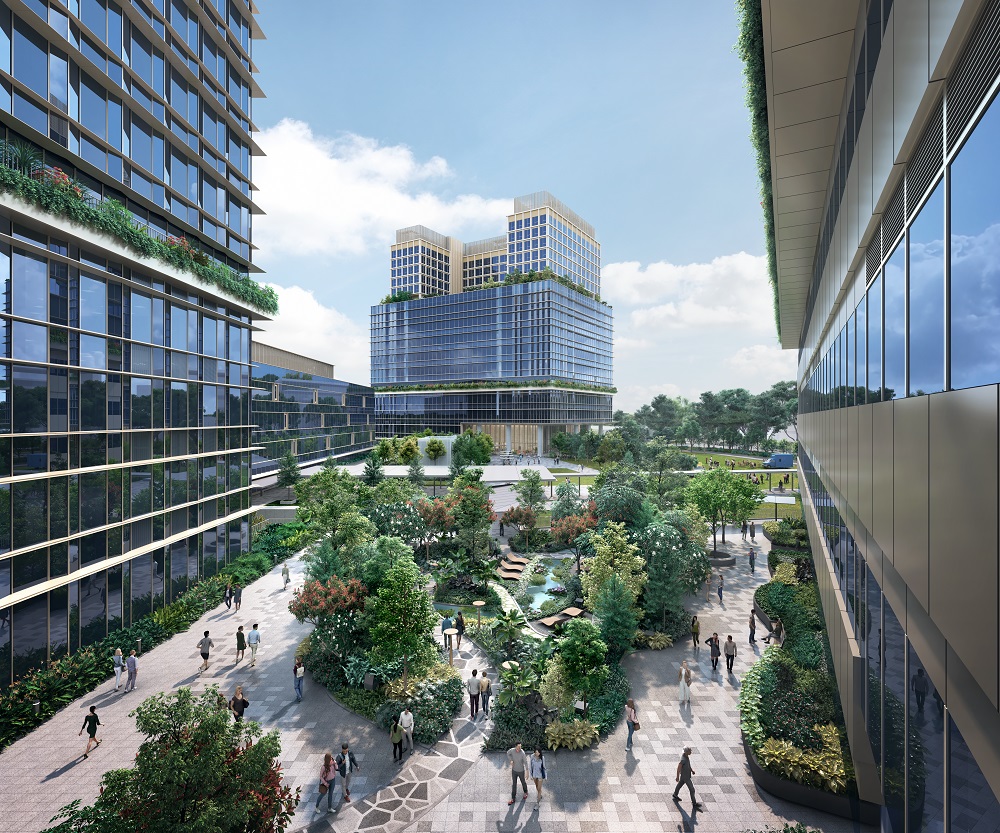
Fresh Vision for a Brighter Tomorrow. Anticipating the future needs of Singapore's modern knowledge-based economy, Singapore Science Park I has embarked on a multi-stage rejuvenation, starting with the first precinct - Geneo. As a world-class hub for life sciences and innovation, Geneo welcomes sectors such as healthcare, deep tech and digital transformation. With innovation, community and sustainability at its heartbeat, Geneo offers a re-imagined holistic lifestyle for change-makers by placing their needs at the forefront of its design.
In keeping pace with the thriving R&D landscape and to mark the park’s 40th anniversary, Geneo, a new life sciences and innovation cluster is rising progressively within the complex. Slated for completion in 2025, it comprises five new sustainable buildings. Following Geneo’s completion, the park’s population is expected to increase by approximately 75 per cent from 12,000 to 21,000.
The Singapore Science Park in its new chapter, has been envisioned as a welcoming destination for the broader community. Members of the public can look forward to retail options and other amenities such as an all-weather event plaza with a dramatic louvred glass canopy for large-scale community events, alongside an interconnected basement for seamless connectivity to Kent Ridge MRT station.
Placemaking programmes, such as Art Jam Science Park, Flavours of Tomorrow, and Innovation Made Real have been rolled out for the community as testament to the park’s values of collaboration, creativity, inclusivity and innovation.
Notes
1. https://eresources.nlb.gov.sg/newspapers/Digitised/Article/straitstimes19871005-1.2.23.6?ST=1&AT=search&k=pig%20hearts%20and%20singapore%20science%20park%20and%20brine&QT=pig,hearts,and,singapore,science,park,and,brine&oref=article
2. https://eresources.nlb.gov.sg/newspapers/Digitised/Article/straitstimes19930909-1.2.78.17?ST=1&AT=search&k=pig%20and%20heart%20and%20singapore%20science%20park&QT=pig,and,heart,and,singapore,science,park&oref=article; https://www.worldscientific.com/doi/pdf/10.1142/9789814641272_bmatter
3. 1982: Science Park I welcomes its first tenant Facts and figures PUBLICATION: ST 22/10/2007 PAGE: H6 NO. OF WORDS: 448
4. https://eresources.nlb.gov.sg/infopedia/articles/SIP_2022-05-20_141234.html
5. https://www.worldscientific.com/doi/pdf/10.1142/9789814641272_bmatter pg 249
6. https://eresources.nlb.gov.sg/newspapers/Digitised/Article/biztimes19840117-1.2.10?ST=1&AT=search&k=lentinan%20and%20singapore%20science%20park&QT=lentinan,and,singapore,science,park&oref=article
7. https://eresources.nlb.gov.sg/newspapers/Digitised/Article/biztimes19840117-1.2.10?ST=1&AT=search&k=lentinan%20and%20singapore%20science%20park&QT=lentinan,and,singapore,science,park&oref=article
8. https://eresources.nlb.gov.sg/newspapers/Digitised/Article/biztimes19841129-1.2.3?ST=1&AT=search&k=lentinan%20and%20singapore%20science%20park&QT=lentinan,and,singapore,science,park&oref=article
9. https://www.worldscientific.com/doi/pdf/10.1142/9789814641272_bmatter
10. https://www.bis.org/review/r150807b.htm
11.https://eresources.nlb.gov.sg/newspapers/Digitised/Article/straitstimes19930731-1.2.9.2?ST=1&AT=search&k=Shimadzu%20Corporation%20and%20science%20park%20and%20gamma&QT=shimadzu,corporation,and,science,park,and,gamma&oref=article
12. https://eresources.nlb.gov.sg/newspapers/Digitised/Article/biztimes19900511-1.2.11.3?ST=1&AT=search&k=Shimadzu%20Corporation%20and%20science%20park%20and%20gamma&QT=shimadzu,corporation,and,science,park,and,gamma&oref=article
13. https://eresources.nlb.gov.sg/newspapers/Digitised/Article/newpaper19960419-1.2.16?ST=1&AT=search&k=Cray%20T94&QT=cray,t94&oref=article
14. https://www.roots.gov.sg/en/stories-landing/stories/jurong-industrial-estate/story; https://www.nhb.gov.sg/~/media/nhb/files/places/trails/jurong/jurong%20heritage_24042015_preview.pdf
15. https://www.foundersmemorial.gov.sg/shapeourmemorial/en/onlineexhibition/detail/proudly-made-in-singapore
16. Changing the landscape to suit the times BY: CLARRISA TAN PUBLICATION: BT 12/08/2008 PAGE: 30 NO. OF WORDS: 1136
17. https://www.bis.org/review/r150807b.htm
18. https://www.worldscientific.com/doi/pdf/10.1142/9789814641272_bmatter
19.Changing the landscape to suit the times BY: CLARRISA TAN PUBLICATION: BT 12/08/2008 PAGE: 30 NO. OF WORDS: 1136
20. Swee Kee Siong write-up
21. Swee Kee Siong write-up
22. https://eresources.nlb.gov.sg/newspapers/Digitised/Article/singmonitor19830729-2.2.7.11?ST=1&AT=filter&DF=&DT=&AO=true&NPT=&L=&CTA=&NID=&CT=ARTICLE&WC=&YR=&K="Singapore+science+park"&KA="Singapore+science+park"&P=1&Display=0&filterS=0&QT="singaporesciencepark"&oref=article1983: NCB GETS $19 M NEW HOME IN SINGAPORE SCIENCE PARK SINGAPORE MONITOR - 2nd Edition, 29 July 1983, Page 6
23. Seetoh-Yam Kum Chun write-up
24. https://eresources.nlb.gov.sg/newspapers/Digitised/Article/straitstimes19930529-1.2.101.2.4?ST=1&AT=filter&DF=&DT=&AO=true&NPT=&L=&CTA=&NID=&CT=&WC=&YR=&K=%22Singapore+science+park%22&KA=%22Singapore+science+park%22&P=29&Display=0&filterS=0&QT=%22singaporesciencepark%22&oref=article
25. https://eresources.nlb.gov.sg/newspapers/Digitised/Article/straitstimes19840118-1.2.74?ST=1&AT=search&k=Det%20Norske%20Veritas%20Marine%20Technology%20Centre%20and%20sparkling%20glasses&QT=det,norske,veritas,marine,technology,centre,and,sparkling,glasses&oref=article
26. https://eresources.nlb.gov.sg/newspapers/Digitised/Article/biztimes19820304-1.2.14.5?ST=1&AT=filter&DF=&DT=&AO=true&NPT=&L=&CTA=&NID=&CT=&WC=&YR=&K=%22Singapore+science+park%22&KA=%22Singapore+science+park%22&P=20&Display=0&filterS=0&QT=%22singaporesciencepark%22&oref=article
27. https://www.worldscientific.com/doi/pdf/10.1142/9789814641272_bmatter
28. https://eresources.nlb.gov.sg/infopedia/articles/SIP_372_2004-12-23.html#:~:text=The%20first%20AIDS%20death%20in,number%20of%20new%20cases%20doubled
29. https://eresources.nlb.gov.sg/newspapers/Digitised/Article/straitstimes19870928-1.2.61.2?ST=1&AT=filter&DF=&DT=&AO=true&NPT=&L=&CTA=&NID=&CT=ARTICLE&WC=&YR=&K=%22Singapore+science+park%22&KA=%22Singapore+science+park%22&P=10&Display=0&filterS=0&QT=%22singaporesciencepark%22&oref=article
30. https://eresources.nlb.gov.sg/newspapers/Digitised/Article/straitstimes19870928-1.2.61.2?ST=1&AT=filter&DF=&DT=&AO=true&NPT=&L=&CTA=&NID=&CT=ARTICLE&WC=&YR=&K=%22Singapore+science+park%22&KA=%22Singapore+science+park%22&P=10&Display=0&filterS=0&QT=%22singaporesciencepark%22&oref=article
31. https://eresources.nlb.gov.sg/infopedia/articles/SIP_2022-05-20_141234.html
32. https://investor.capitaland-ascendasreit.com/misc/ar2011/bizsciencepark.pdf
33. https://eresources.nlb.gov.sg/newspapers/Digitised/Article/straitstimes19940816-1.2.58.7?ST=1&AT=filter&DF=&DT=&AO=true&NPT=&L=&CTA=&NID=&CT=&WC=&YR=&K=%22Singapore+science+park%22&KA=%22Singapore+science+park%22&P=24&Display=0&filterS=0&QT=%22singaporesciencepark%22&oref=article
34. https://eresources.nlb.gov.sg/newspapers/Digitised/Article/straitstimes19911011-1.2.68.4?ST=1&AT=filter&DF=&DT=&AO=true&NPT=&L=&CTA=&NID=&CT=&WC=&YR=&K="Singapore+science+park"&KA="Singapore+science+park"&P=25&Display=0&filterS=0&QT="singaporesciencepark"&oref=article
35. https://eresources.nlb.gov.sg/newspapers/Digitised/Article/biztimes19901012-1.2.20.1?ST=1&AT=filter&DF=&DT=&AO=true&NPT=&L=&CTA=&NID=&CT=&WC=&YR=&K=%22Singapore+science+park%22&KA=%22Singapore+science+park%22&P=13&Display=0&filterS=0&QT=%22singaporesciencepark%22&oref=article
36. https://eresources.nlb.gov.sg/newspapers/Digitised/Article/singmonitor19830729-2.2.7.11?ST=1&AT=filter&DF=&DT=&AO=true&NPT=&L=&CTA=&NID=&CT=ARTICLE&WC=&YR=&K=%22Singapore+science+park%22&KA=%22Singapore+science+park%22&P=1&Display=0&filterS=0&QT=%22singaporesciencepark%22&oref=article
37. https://www.nas.gov.sg/archivesonline/data/pdfdoc/mbt19890909s.pdf
38. https://eresources.nlb.gov.sg/infopedia/articles/SIP_2022-05-20_141234.html
39. https://eresources.nlb.gov.sg/newspapers/Digitised/Article/biztimes19930407-1.2.12.3?ST=1&AT=search&k=$291%20million%20and%20Singapore%20Science%20Park%20Two&QT=291,million,and,singapore,science,park,two&oref=article
40. https://www.nas.gov.sg/archivesonline/photographs/record-details/1745b403-1162-11e3-83d5-0050568939ad
41. https://eresources.nlb.gov.sg/newspapers/Digitised/Article/biztimes19960622-1.2.28.9.2?ST=1&AT=filter&DF=&DT=&AO=true&NPT=&L=&CTA=&NID=&CT=&WC=&YR=&K=%22Singapore+science+park%22&KA=%22Singapore+science+park%22&P=20&Display=0&filterS=0&QT=%22singaporesciencepark%22&oref=article
42. https://www.worldscientific.com/doi/pdf/10.1142/9789814641272_bmatter pg 252
43. https://www.nas.gov.sg/archivesonline/data/pdfdoc/mbt19890909s.pdf
44. https://www.google.com/url?q=https://eresources.nlb.gov.sg/newspapers/Digitised/Article/straitstimes19930906-1.2.33.6?ST%3D1%26AT%3Dfilter%26DF%3D%26DT%3D%26AO%3Dtrue%26NPT%3D%26L%3D%26CTA%3D%26NID%3D%26CT%3D%26WC%3D%26YR%3D%26K%3D%2522Singapore%2Bscience%2Bpark%2522%26KA%3D%2522Singapore%2Bscience%2Bpark%2522%26P%3D16%26Display%3D0%26filterS%3D0%26QT%3D%2522singaporesciencepark%2522%26oref%3Darticle&sa=D&source=docs&ust=1684420821355324&usg=AOvVaw07AvjvVC3gIwnd3nIPafhP
45. https://eresources.nlb.gov.sg/newspapers/Digitised/Article/straitstimes19961203-1.2.60.3?ST=1&AT=search&k=%22Singapore%20science%20park%22%20and%2038%20and%20innovation%20centre&QT=%22singaporesciencepark%22,and,38,and,innovation,centre&oref=article
46. https://eresources.nlb.gov.sg/newspapers/Digitised/Article/straitstimes19930906-1.2.33.6?ST=1&AT=filter&DF=&DT=&AO=true&NPT=&L=&CTA=&NID=&CT=&WC=&YR=&K=%22Singapore+science+park%22&KA=%22Singapore+science+park%22&P=16&Display=0&filterS=0&QT=%22singaporesciencepark%22&oref=article
47. Eli Lilly to boost R&D in S'pore by US$150m BY: CHEN HUIFEN PUBLICATION: BT 27/03/2007 PAGE: 4
48. Danish food giant opens innovation centre here BY: NARENDRA AGGARWAL PUBLICATION: ST 13/10/2005 PAGE: H17
49. The industrial revolution 2000 BY: JOYCE KHOR & TEO LI KIM PUBLICATION: BT 29/06/2000 PAGE: 35
50. https://www.capitaland.com/en/about-capitaland/newsroom/news-releases/international/2020/oct/smart-urban-co-innovation-lab-opens-in-capitaland-singapore-science-park.html




